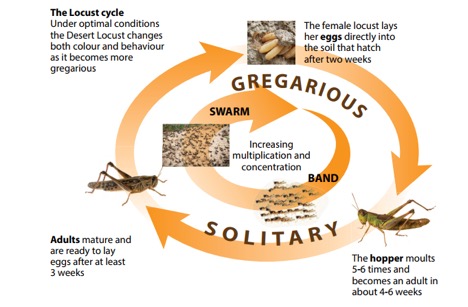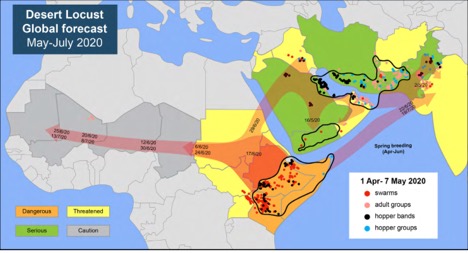Introduction
- Locust are short-horned grasshoppers. These species under favourable climatic conditions congregate, that move together as bands and swarm over long distances crossing over countries and continents rapidly, stripping fields and enormously damaging crops
- Adult locust swarms can fly up to 150 km a day with the wind and they can consume roughly their own weight in fresh food per day
- Even a very small swarm can eat as much in one day as about 35,000 people
- If allowed to breed unchecked in favourable conditions, locusts can form huge swarms that can strip trees and crops over vast areas
- The unprecedented behaviour of desert locusts has become the cause of concern, for India. Recently, India faced the worst locust attack in about 27 years

Locust Warning Organisation (LWO)
- The Locust Control and Research (LC&R) scheme is responsible for control of Desert Locust in India which is being implemented through Organisation known as Locust Warning Organisation (LWO) established in 1939
- LWO is responsible to monitor and control the locust situation in the Scheduled Desert Area (SDA) mainly in the States of Rajasthan and Gujarat while partly in the States of Punjab and Haryana
- It keeps itself abreast with the prevailing locust situation at National and International level through monthly Desert Locust Bulletins of FAO
Control Measures:
- A robust approach is required by the Union Government agencies and various departments of states for the effective desert locust control
- The mitigation at the hopper stage can be most effective. Because locusts are most vulnerable at this stage
- When the adult locusts emerge from the fifth-instar hoppers and mature; they form swarms and fly away. So, it gets difficult to control them
- The pesticides, which are active for a short time, should be used to minimise environmental damages
- Drones can also be used to spray pesticides on tall trees and inaccessible places for effective control of locusts
- Directives from the United Nations Food and Agriculture Organisation, which is monitoring the situation on a global scale, should be followed diligently for effective locust control
- India has also proposed a trilateral initiative with Pakistan and Iran for effective locust control. The Indian Meteorological Department should provide the wind pattern data for proper tracking of the movement of locust swarms
- Safeguarding livelihoods and promoting recovery through cash interventions, supplementary livestock feed, and livelihood recovery and farming packages
Case Study: Swarms of locusts have invaded vast swathes of land in India since April 11th
2020. They entered several districts of Rajasthan via Sindh province Pakistan. Favourable rain-bearing winds aided their transport towards India. This locust attack has affected about 90,000 hectares across 20 districts in Rajasthan

 Profile
Profile Settings
Settings Refer your friends
Refer your friends Sign out
Sign out













